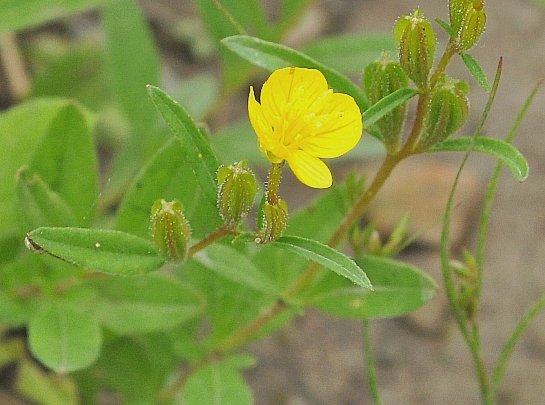Description: This perennial wildflower is 8-24" long, unbranched or sparingly branched, and erect to ascending. The stems are light green to pale red and terete; they are often pubescent above, becoming glabrous below. The alternate leaves are up to 2½" long and ¾" across; they are medium green, glabrous to slightly pubescent, and narrowly ovate or elliptic. The base of each leaf is sessile, while its tip is blunt. In addition to the alternate leaves, the basal leaves are often present at the bottom of each plant. The central stem (and any lateral stems) terminates in a leafy spike of several flowers; it is usually several inches long. Individual flowers usually alternate along the spike, although sometimes they occur in pairs. At the base of each flower, there is a leafy bract about ½–1" long that is linear-oblong. The central stalk of the spike is often pubescent.

Each flower is
about ½–¾" across, consisting of 4 yellow petals, 4 green or reddish
green calyx lobes, a slender calyx tube that is often reddish, and an
ovary that is located below the calyx tube. There are also several
yellow stamens and a central style with a cross-shaped stigma. The
well-rounded petals are often slightly notched at their tips. Each
petal has a central vein, from which several lateral veins radiate from
both sides; these veins are pale-colored and rather inconspicuous. The
calyx lobes are lanceolate in the shape and pubescent on their outer
surfaces; they eventually hang downward from the petals and turn
yellow. The calyx tube is about the same length or a little shorter
than the ovary. The blooming period occurs from early to mid-summer and
lasts about a month; the flowers are diurnal. After the blooming
period, each fertile flower is replaced by a pubescent seed capsule
about ½" long; it is ovoid-obovoid with 4 strongly winged margins along
its sides that are reddish green. Each capsule contains numerous seeds.
Cultivation:
The preference is full or partial sun, moist to dry-mesic conditions,
and sandy or gravelly soil.
Range & Habitat:
Small Sundrops is a boreal species that is restricted to NE Illinois,
where it is native.
This plant is rare in Illinois and state-listed as 'endangered.'
Habitats
include sand prairies, gravel prairies, sandy savannas and open
woodlands, and abandoned sandy fields. In some parts of its range, this
wildflower is found in damp depressions of various kinds. Occasional
wildfires and brush-removal are beneficial because they reduce
competition from woody vegetation.
Faunal Associations:
The flowers are cross-pollinated by bees, skippers, and butterflies; a
Halictid bee, Lasioglossum oenotherae, is an
oligolege (specialist pollinator) of Oenothera spp.
These insects suck nectar from the flowers, and some bees also collect
pollen for their larvae. There are several insects that feed on Oenothera
spp. They include the caterpillars of Eudryas unio
(Pearly Wood Nymph), Schinia florida (Primrose
Moth), and some Mompha spp. (Momphid Moths). Other
insect feeders include the weevils Tyloderma foveolatum and Chalcodermus collaris, and the aphid Anoecia
oenotherae. The seeds of Oenothera spp.
are eaten to a minor extent by the Eastern Goldfinch and Mourning Dove,
while the foliage is sometimes eaten by White-Tailed Deer.
Photographic Location:
A nature preserve in Cook County, Illinois. The photograph was taken by
Lisa Culp (Copyright © 2009).
Comments:
Small Sundrops is a pretty little plant that blooms during the day. It
resembles the often cultivated Oenothera fruticosa
(Common Sundrops), but this latter plant has larger flowers (1" across
or more) that bloom together in rather flat-topped clusters. In
contrast, the flowers of Small Sundrops bloom along a more elongated
floral spike. Other Oenothera spp. have seed
capsules that lack the strongly winged margins that are characteristic
of Small Sundrops' seed capsules. Some Oenothera spp.
have night-blooming flowers that are pollinated by Sphinx moths; they
are commonly referred to as 'Evening Primroses' rather than Sundrops.